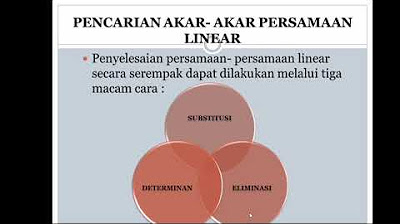Metode Newton Raphson (Konsep & Contoh) [Metode Numerik]
Summary
TLDRIn this educational video, the instructor explains the Newton-Raphson method for finding roots of non-linear equations. The method, categorized as an open method, starts with an initial guess and iteratively improves the estimate using the function and its derivative. Key assumptions for the method include the function being continuous, the presence of a derivative, and a non-zero derivative at the guess point. The video covers graphical interpretation, examples, convergence analysis, and the method's limitations. While Newton-Raphson offers quadratic convergence for simple cases, it struggles with multiple roots or distant initial guesses.
Takeaways
- 😀 Newton-Raphson is an open-method used to find the roots of non-linear equations, relying on an initial guess and the function's derivative.
- 😀 Unlike bisection methods that use intervals, Newton-Raphson uses a starting point and iteratively refines guesses based on function and derivative values.
- 😀 Key assumptions for the method include continuity of the function, the existence of its derivative, and a non-zero derivative at the initial guess.
- 😀 Graphically, Newton-Raphson uses a tangent line to the function at the initial guess to estimate the root by finding where the tangent intersects the x-axis.
- 😀 The method is iterative; each iteration updates the guess using the formula: x_{n+1} = x_n - f(x_n) / f'(x_n).
- 😀 Convergence of Newton-Raphson is quadratic when the initial guess is sufficiently close to the actual root.
- 😀 A function's convergence is guaranteed when the error decreases rapidly between iterations, especially if the guess is close to the root.
- 😀 The method can fail or converge slowly when the initial guess is far from the true root or when the function has multiple roots.
- 😀 Special cases where the method struggles include when the derivative is zero at the guess, when the root is multiple, or when the method oscillates without approaching the root.
- 😀 In some cases, the method will not converge to the correct root, especially if the function's behavior at the initial guess is not suitable (e.g., flat or oscillating behavior).
Q & A
What is the main focus of the lesson in this video?
-The main focus of the lesson is the Newton-Raphson method for solving non-linear equations using open methods. The lesson covers assumptions, graphical interpretation, examples, and convergence analysis.
How does the Newton-Raphson method differ from closed methods like the bisection method?
-The Newton-Raphson method is an open method that starts with an initial guess (x0) and iteratively refines the guess based on the function and its derivative, while the bisection method works with an interval and requires the function to change signs at the endpoints of the interval.
What assumptions are necessary for the Newton-Raphson method to work?
-The function must be continuous, have a derivative, and the initial guess must not make the derivative zero at that point.
What is the graphical interpretation of the Newton-Raphson method?
-Graphically, the method starts with an initial guess and uses the tangent line at that point to estimate the root. The tangent intersects the x-axis, and this intersection becomes the next guess, which is repeated until convergence.
Why is it important for the derivative not to be zero in the Newton-Raphson method?
-If the derivative at the initial guess is zero, the tangent line becomes horizontal, and the method will fail to provide a valid estimate for the root because the division by zero would occur.
How is the next guess calculated in the Newton-Raphson method?
-The next guess (x1) is calculated using the formula: x1 = x0 - f(x0) / f'(x0), where f(x0) is the value of the function at the initial guess, and f'(x0) is the value of its derivative.
What happens if the Newton-Raphson method does not converge?
-If the method does not converge, it may indicate that the initial guess is far from the actual root, or the function has multiple roots, causing slow convergence. In such cases, a modified approach or a different method may be necessary.
What is the convergence rate of the Newton-Raphson method?
-The Newton-Raphson method converges quadratically, meaning that the number of correct digits roughly doubles with each iteration, as long as the initial guess is sufficiently close to the root.
What are some potential problems when using the Newton-Raphson method?
-Potential problems include divergence when the initial guess is too far from the root, failure when the derivative at the initial guess is zero, and slow convergence when the function has multiple roots.
When is the Newton-Raphson method particularly unsuitable?
-The method is unsuitable when the initial guess is too far from the true root, when the function has multiple roots, or when the derivative is zero at the initial guess, as it can lead to divergence or slow convergence.
Outlines

This section is available to paid users only. Please upgrade to access this part.
Upgrade NowMindmap

This section is available to paid users only. Please upgrade to access this part.
Upgrade NowKeywords

This section is available to paid users only. Please upgrade to access this part.
Upgrade NowHighlights

This section is available to paid users only. Please upgrade to access this part.
Upgrade NowTranscripts

This section is available to paid users only. Please upgrade to access this part.
Upgrade NowBrowse More Related Video

METODE NUMERIK P7 PART 1/2 | METODE NEWTON-RAPHSON UNTUK MENYELESAIKAN PERSAMAAN NON LINIER

8. METODE LELARAN TITIK TETAP - FIX POINT ITERATION - METODE NUMERIK

5 MTK EKO PENCARIAN AKAR AKAR PERS LINEAR

SOLVING SYSYEM OF NONLINEAR EQUATIONS || PRECALCULUS

Bisection Method | Numerical Methods

Cara menentukan himpunan penyelesaian sistem persamaan linear tiga variabel
5.0 / 5 (0 votes)